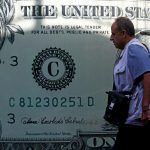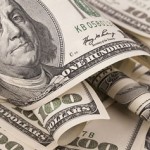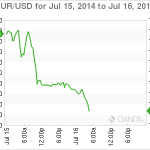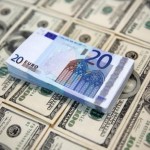EUR/USD Below 1.3430 as traders earn from bullish turn

The dollar was about 0.1 percent from the strongest level in eight months against the euro as investors raised bets it would climb versus the single currency to the most since November 2012.
The U.S. currency maintained its biggest weekly advance since March against major peers before reports forecast to show growth in services held near the fastest pace in at least three years, employers added more than 200,000 jobs for a sixth month, and economic growth rebounded last quarter. The Federal Reserve meets from tomorrow to debate the pace of interest-rate increases and whether to further reduce bond purchases. The New Zealand dollar fell to a one-month low.
“The Fed’s reaction to the already stronger data will be interesting, but policy is absolutely dependent on the data going forward,” said Sam Tuck, a senior currency strategist at ANZ Bank New Zealand Ltd. “The bias is for the U.S. dollar to creep higher. You’d expect the euro to remain under pressure in the short term.”
The dollar was at $1.3434 per euro at 7:38 a.m. in London, little changed from July 25, when it reached $1.3422, the strongest since Nov. 21. The U.S. currency was at 101.87 yen from 101.84 at the end of last week. The euro was little changed at 136.84 yen.
The Bloomberg Dollar Spot Index, which tracks the U.S. currency against 10 major counterparts, was little changed at 1,014.05 from the end of last week, when it rose 0.5 percent, the most since the period ending March 21, and touched 1,014.39, the highest since June 18.
Dollar Longs
Futures traders increased bullish bets on the dollar versus the euro to the most since November 2012. The difference in the number of wagers by hedge funds and other large speculators on an advance in the greenback against the shared currency compared to those on a decline — so-called net longs — was 88,823 on July 22, compared to 62,846 in the previous week, figures from the Washington-based Commodity Futures Trading Commission show. Net dollar longs versus the yen declined to 53,916, the least since May 20.
Standard Chartered Bank Plc lowered its year-end forecast for the dollar to 106 yen from 110. The median estimate of analysts surveyed by Bloomberg News is for 105.
“The timing of when the U.S. economy becomes more robust and Fed policy makers reach a consensus that yields will start rising will probably be slightly pushed back,” said Koichi Yoshikawa, sales director of financial markets in Japan at Standard Chartered. “The dollar will probably reach a peak against the yen in the first quarter next year, rather than year-end as we previously estimated.”
U.S. Recovery
The preliminary reading of a Purchasing Managers’ Index of U.S. services from Markit Economics was at 59.8 in July, according to the median estimate of economists in a Bloomberg survey. That would be the ninth-straight month above the 50 level that divides expansion from contraction.
Economists in a separate Bloomberg survey predict the U.S. Commerce Department will say on July 30 that gross domestic product rose at a 3 percent annualized rate in the second quarter. The 2.9 percent contraction in the first quarter was the worst reading since the same three months in 2009. A Labor Department report on Aug. 1 will show nonfarm payrolls increased 231,000 in July, economists’ forecasts show.
Best Performer
The dollar has risen 1.3 percent in the past month, the best performer among 10 developed-nation currencies tracked by Bloomberg Correlation-Weighted Indexes. The yen has gained 0.8 percent in the same period, while the euro has lost 0.5 percent.
The New Zealand dollar slid against all its major peers. The kiwi dropped 0.2 percent to 85.36 U.S. cents after touching 85.34 cents, the least since June 12. It reached 88.36 cents on July 10, the strongest since the post-float high of 88.43 set in August 2011.
Reserve Bank of New Zealand Governor Graeme Wheeler said on July 24 that the currency’s level is “unjustified and unsustainable,” after signaling a pause following four interest rate increases this year.
“It’s relatively new for the RBNZ to take such an aggressive tone,” said ANZ Bank’s Tuck. ANZ sees the currency finishing the year at 83 U.S. cents, compared with a median estimate of 85 in a Bloomberg survey of analysts.
Source: Bloomberg





























